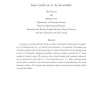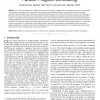1729 search results - page 109 / 346 » On Bounds for the k-Partitioning of Graphs |
CORR
2008
Springer
14 years 10 months ago
2008
Springer
A solution to a problem of Erdos, Rubin and Taylor is obtained by showing that if a graph G is (a : b)-choosable, and c/d > a/b, then G is not necessarily (c : d)-choosable. Th...
TPDS
1998
14 years 9 months ago
1998
—One of the main obstacles in obtaining high performance from message-passing multicomputer systems is the inevitable communication overhead which is incurred when tasks executin...
SODA
2010
ACM
14 years 9 months ago
2010
ACM
We consider the following marking process (rw-rand) made by a random walk on an undirected graph G. Upon arrival at a vertex v, it marks v if unmarked and otherwise it marks a ran...
NETWORKS
2010
14 years 8 months ago
2010
Let G = (V, E, Q) be a undirected graph, where V is the set of vertices, E is the set of edges, and Q = {Q1, . . . , Qq} is a partition of V into q subsets. We refer to Q1, . . . ...
RSA
2010
14 years 8 months ago
2010
In this paper we analyze the appearance of a Hamilton cycle in the following random process. The process starts with an empty graph on n labeled vertices. At each round we are pre...


